The top 10 fights that transcended boxing
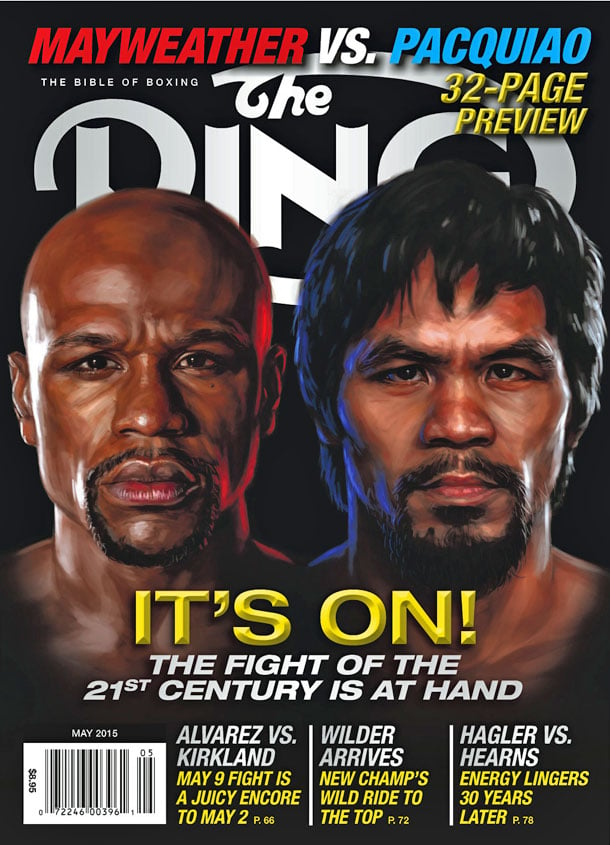
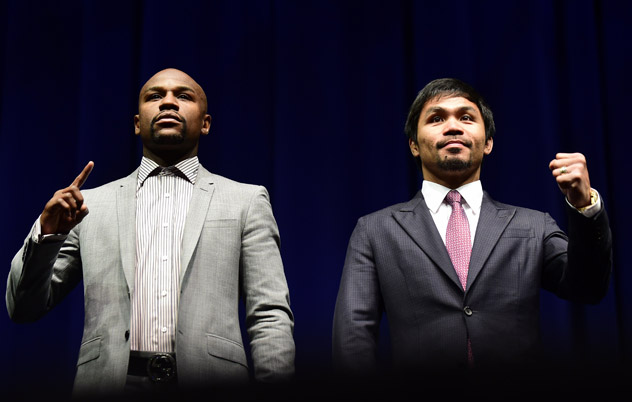
Photo by Frederic J. Brown / Getty Images
We’re in the midst of a special time. Boxing, for once, will be front-page news and dominate sports coverage like the NFL, NBA and Major League Baseball usually do – and it’s the Floyd Mayweather-Manny Pacquiao megafight that will force the myopic mainstream sports media to put boxing there over the next few weeks.
The reason is simple: Mayweather-Pacquiao transcends boxing. It’s one of those rare generational occurrences featuring two fighters that have grabbed the public’s imagination and people want to see it. But it is a little more involved than that.
Pacquiao will be the sentimental choice of most, by the way he carries himself with his seemingly humble approachability and his modest past. Mayweather may carry the precious ‘0,’ but he will play the role of the “bad guy,” whether he likes it or not. The truth is most mainstream sports fans don’t know much about either fighter, though they do know Mayweather has had past issues with the law, done a little time in jail because of it, and is viewed in general, whether accurate or not, as a spoiled ingrate.
There is a racial and generational undertone involved, too.
Many younger African-American fans identify with the 38-year-old Mayweather, while most Asian, Latino and older fans seem tethered to the 36-year-old Pacquiao.
Anyway the storylines for this fight get twisted, it does in many ways fall in line with some of the most anticipated fights in boxing history. RingTV.com takes an unscientific look at the 10 biggest mega-fights in history, based on their event appeal, not so much the quality of the fight.
- Evander Holyfield KO 3 Mike Tyson II, June 28, 1997, Las Vegas
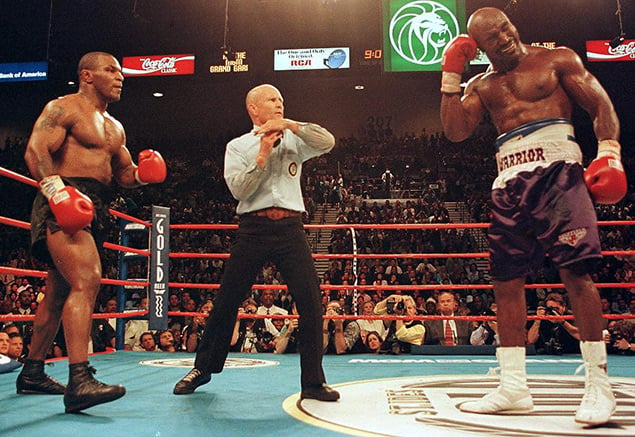
Photo by Jeff Haynes-AFP
“The Bite Fight,” as it’s been infamously dubbed, actually began with overwhelming fanfare because of the first Holyfield-Tyson fight. Holyfield was a 25-to-1 underdog the first time against Tyson. He had dismantled “Iron Mike” and shocked the world with an 11th-round stoppage in November 1996. Holyfield was considered done when he met Tyson in their first meeting. “The Real Deal” was 2-2 in his previous four fights and was believed to pose little threat to Tyson – so Don King handpicked him – and Holyfield pulled off the upset. That set up the rematch: A revived Holyfield against the still-menacing Tyson.
Result: Something strange occurred in the third round. With less than a minute left, Tyson positioned his head up against the side of Holyfield’s head during a clinch and bit the tip of Holyfield’s right ear. Holyfield stomped and shoved Tyson away. Referee Mills Lane tried to restore order and figure out what was going on. After consulting with the ringside physician, and deducting two points from Tyson for the bite, Lane opted to let the fight resume. This time, Tyson nibbled on Holyfield’s left ear. Lane saw enough. After the round, he disqualified Tyson and “The Bite Fight” was stamped into the wild, wacky section of boxing history.
- Felix Trinidad MD 12 Oscar De La Hoya, Sept. 18, 1999, Las Vegas
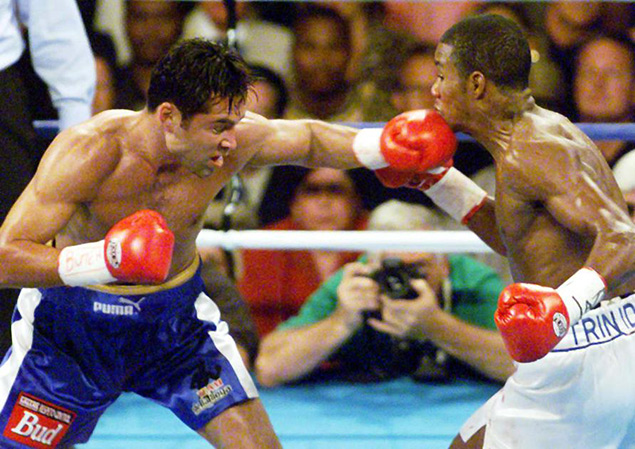
Photo by Hector Mata-AFP
Called “The Fight of the Millennium,” this matched two highly popular, undefeated Latino champions and was the last mega-fight of the century. Trinidad was, and still is today, one of the most admired Puerto Rican stars ever. De La Hoya had the matinee idol looks and a number of credible victories on his resume. This fight was believed to be a defining point in both of their careers. They were both 26 and had a combined record of 66-0 with 56 victories coming within the distance. De La Hoya was just over a year shy of stopping Mexican legend Julio Cesar Chavez, and Trinidad was seven months removed from dominating Pernell Whitaker.
Result: The fight generated 1.4 million pay-per-view buys, the most for any non-heavyweight fight then, and has since been exceeded by the 2.4-million buys De La Hoya and Mayweather generated in 2007. The fight itself was a bit of a dud, not living up to the hype. De La Hoya danced his way to a points lead, until Hall of Fame trainer Gil Clancy gave “The Golden Boy” some bad advice and advised him to coast the last four rounds. It cost De La Hoya his first career loss.
- Sonny Liston KO 1 Floyd Patterson I, September 25, 1962, Chicago, Ill.
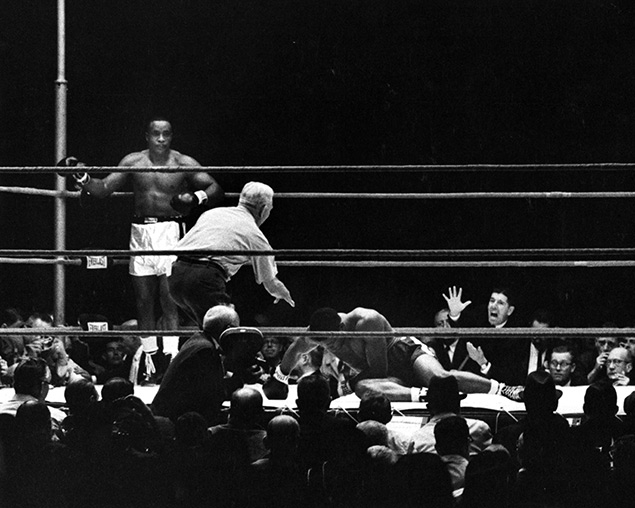
Photo from THE RING archives
No one wanted Patterson, then the heavyweight champ, to fight Liston. It was the cause for Patterson to cut ties with legendary manager Cus D’Amato, who didn’t want Patterson anywhere near Liston because of his alleged mob ties. Supposedly, President John F. Kennedy urged Patterson not to fight Liston, either. Liston had a surly reputation, and the NAACP tried to coerce Patterson from fighting Liston in fear that it would hurt the civil rights movement and feed into what white America thought of blacks at the time.
Result: Liston crushed the far smaller Patterson. Liston came in at 214 and Patterson was 189 pounds. Liston also knew Patterson feared him and made sure to impose that intimidation. Liston stunned Patterson with a right uppercut midway through the first round. Liston dropped Patterson with a left hook and that was it. Patterson was counted out before 18,894 fans at Comiskey Park. Patterson, the first fighter in boxing history to regain the heavyweight title, and Liston fought again in 1963 with the same result. That time, however, Patterson brought a disguise fearing the same outcome and wanted to spare himself any post-fight embarrassment. After Liston beat Patterson in ’63, he fought a brash kid from Louisville, Kentucky named Cassius Clay.
- Pernell Whitaker D 12 Julio Cesar Chavez, Sept. 10, 1993, San Antonio, Texas
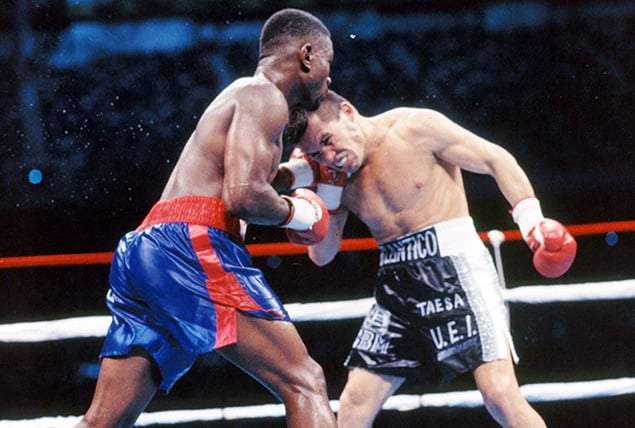
Photo from THE RING archives
It was the Pacquiao-Mayweather fight of its time. The two future Hall of Famers were among the top two pound-for-pound fighters for some time. Whitaker was the top welterweight in the world, Chavez agreed to come up in weight and the two decided to meet at 145 pounds for Whitaker’s WBC title. Chavez was a popular Mexican legend, and arguably the greatest Mexican fighter of all-time. He was also 87-0. Whitaker, a defensive wizard who was an Olympic gold medalist, was 32-1 (and the one loss was regarded as an egregious robbery).
Result: In the opinion of almost everyone who saw the fight, Whitaker brilliantly out-boxed Chavez. But judges Mickey Vann and Franz Marti somehow saw it as a 115-115 draw, while judge Jack Woodruff had Whitaker winning 115-113. Chavez didn’t exactly carry himself as the sportsman afterward proclaiming he had no respect for Whitaker, whining about Whitaker’s so-called “tactics.”
- Roberto Duran W 15 Sugar Ray Leonard I, June 20, 1980, Montreal, Canada

Photo from THE RING archives
At the time, it was richest fight in boxing history. Leonard was taking over for the faded Muhammad Ali as the face of boxing. He was also returning to Montreal, where his career was launched as the gleaming future of the sport when he won gold at the 1976 Olympics. Duran, on the other hand, was a fight fan’s fighter. He didn’t have the crossover appeal of the smiling, commercial Leonard, but held the respect of the regular fan for his ferocity. Joe Frazier was asked ringside who Duran reminded him of. Frazier’s reply: “Charles Manson.”
Result: Maybe Leonard was looking for guts points, or was willing to get his ribs tested by the stone-fisted Duran, but Sugar Ray wasn’t “Sugar Ray.” He stood flat footed, playing more into Duran’s brawling game than his own boxing ability. Duran piled more heat on Leonard than he ever previously faced – and it cost him his first loss as a professional. The scores were originally read as Duran being a majority-decision victor. The official ruling was corrected, after Italian judge Angelo Poletti had Duran winning 148-147 – off a scorecard that read: three-rounds Duran, two-rounds Leonard, and 10 rounds even.
- Muhammad Ali KO 8 George Foreman, October 30, 1974, Kinshasa, Zaire
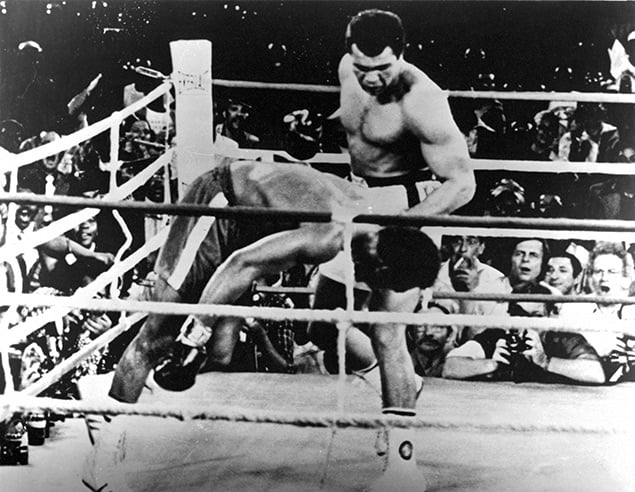
Photo from THE RING archives
Ali, though thought to be finished, was still an attraction. He remained relevant by fighting four times in ’73, opening the year by beating Joe Bugner, losing to Ken Norton, and then avenging the Norton setback with a controversial split-decision victory at the Forum. Ali then closed ’73 with a spirited 12-round sparring session with someone named Rudi Lubbers, before avenging another previous loss in beating Joe Frazier in January 1974. Foreman, meanwhile, was smashing everyone in his path. He knocked down Frazier six times in two rounds to wrest the WBC and WBA world heavyweight titles away. Then, he devoured Norton in two, setting up the fight with Ali in Zaire. What further fueled the crossover appeal for this fight was the backdrop: That earlier incarnation of Foreman carried a standoffish, dour demeanor. Ali, meanwhile, made a complete brand makeover. The despised Ali by some factions in America in the 1960s transformed into a sentimental underdog looking for one last gasp, much like Holyfield was viewed in the first Tyson fight.
Result: Ali won in what was Ring Magazine‘s Fight of the Year. Ali introduced the world to his rope-a-dope, but what gets lost is that Ali had dominated the early portion of the fight, getting out to a nice edge using the right-hand lead. “The Greatest” threw Foreman off by being first, instead of waiting and having Foreman come to him. But in the fifth, Ali changed tactics. He leaned up against the ropes and Foreman came to Ali, who would whisper in “Big George’s” ear, “They told me you could punch, George!” Foreman said later, “I thought he was just one more knockout victim until, about the seventh round, I hit him hard to the jaw and he held me and whispered in my ear: ‘That’s all you got, George?’ Yep, that was it.” Ali was up 70-67, 69-66 and 68-66 on the card of referee Zach Clayton, who stopped it at 2:58 of the eighth round.
- Gene Tunney W 10 Jack Dempsey, Sept. 22, 1927, Chicago, Ill.
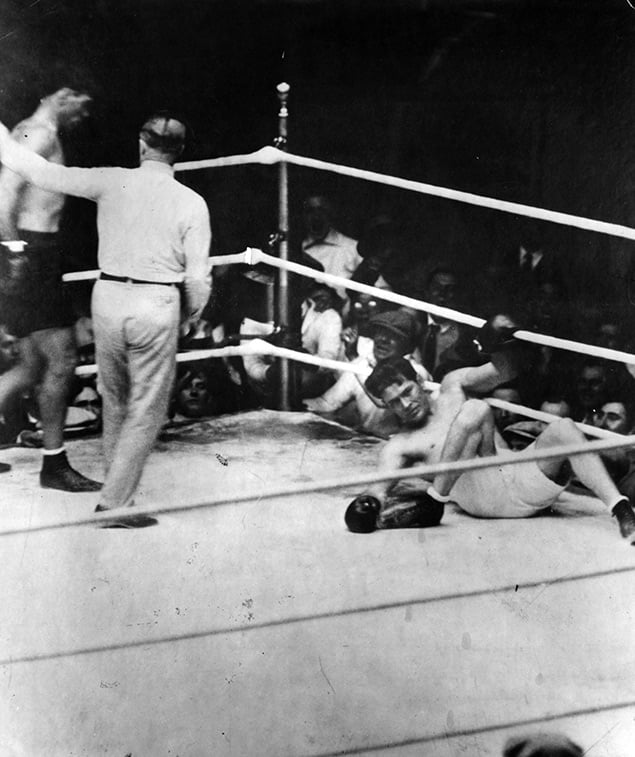
Photo from THE RING archives
This was the rematch, the infamous “Long Count Fight.” Why it transcended anything at the time was because Dempsey transcended anything in the 1920s. The “Manassa Mauler” was an icon, and though he lost the first fight by decision to Tunney, many thought Dempsey would recoup the title in the rematch before 104,943 at Chicago’s legendary Soldier Field. The fight merited front-page attention in the New York Times, and the demand for tickets was insane. Though the ring was 20-square feet, favoring a mover and superior boxer like Tunney, Dempsey was the betting favorite. There were even some suspicions of a fix, since noted Chicago mobster Al Capone secretly had a few duckets on Dempsey.
Result: Dempsey blew his chance at history by becoming the first two-time heavyweight champion for not paying attention to the new Illinois rules that stipulated that if a fighter were to be knocked down, he had 10 seconds to get up while the opposing fighter had to go to a neutral corner. The twist is that it was Dempsey’s people who wanted the rule enforced. Only, their fighter didn’t pay attention when Dempsey floored Tunney in the seventh round with a left hook to the chin. Referee Dave Barry implored Dempsey to go to a neutral corner, but Dempsey choose instead to hover over the fallen Tunney. When Dempsey was convinced to retreat, Tunney used the added time to collect himself and went on to win a unanimous decision.
- Joe Louis KO 1 Max Schmeling, June 22, 1938, New York City
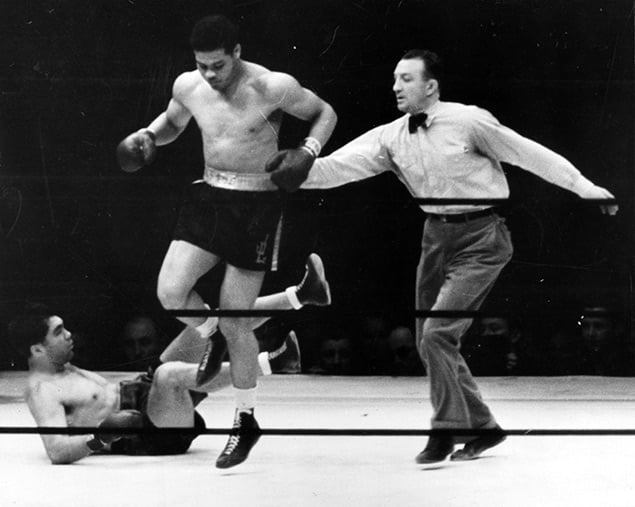
Photo from THE RING archives
Joe Louis was the first crossover African-American superstar athlete – and this fight set the stage. Nazi Germany was building toward war in Europe and Schmeling found himself propped up as Adolf Hitler’s strongman puppet, though Schmeling wasn’t a Nazi and had a Jewish manager, Joe Jacobs. Louis knew he was fighting for his country, but deep inside, he wanted to avenge the only loss of his career, when Schmeling stopped him in the 12th round in 1936. Again, as in many fights, ideologies were foisted on the two combatants. The grave fear was that Schmeling would win and take the heavyweight title back to Germany. Louis made certain it wouldn’t happen. Whereas the first fight he took Schmeling lightly, not training very hard, this fight carried a little more weight for the “Brown Bomber.”
Result: Louis destroyed Schmeling. He showed a ferocity that captivated the 70,000 that filled Yankee Stadium, including ringside movie stars Clark Gable and Gregory Peck. The irony is that Louis was fighting in an arena that wouldn’t allow blacks to play baseball against whites. Anyway, Louis beat Schmeling so severely that the German broadcast plug was pulled. Louis was exalted by both white and black America, while Schmeling was ignored by the Nazi regime for losing to an inferior race in their minds and relegated to a paratroop outfit during World War II. Schmeling and Louis became friends after the war. In fact, as Louis was ailing in his later years, Schmeling helped pay for some of his medical costs.
- Jack Johnson KO 15 Jim Jeffries, July 4, 1910, Reno, Nevada
[springboard type=”video” id=”1509287″ player=”ring003″ width=”648″ height=”511″ ]
This fight could arguably be No. 1. It transcended anything sporting for its time. Johnson is the father of the modern-day athlete, full of self-confidence and piles of ability. He defied what was then the antiquated Victorian mores of the era, gallivanting with white women in public during a period in American history when black men were lynched for even holding a white woman’s hand walking down the street. The views of America were so racially skewed blacks and whites couldn’t even walk on the same sidewalk together. Johnson was well read. He even patented a wrench in 1922. He did what he wanted, when he wanted. Jeffries was buoyed with the unenviable mantle of being the “Great White Hope.” Jeffries was past his prime, but it didn’t really matter. He was a good fighter for his era going against Johnson, who possessed the skillset to fight in any era.
Result: It wasn’t close. Johnson dominated the fight from start to finish. “Lil’ Arthur” proved his superiority by doing something no one had ever done to Jeffries, and that’s twist him up and pull his arms behind him during a clinch. Johnson knocked Jeffries down twice – for the first time in his career – and finished off the alfalfa farmer in the 15th. “I knew what that look meant. The old ship was sinking,” Johnson said after Jeffries’ reaction to an uppercut in the fourth round. “I could never have whipped Johnson at my best,” Jeffries admitted afterward. “I couldn’t have hit him. No, I couldn’t have reached him in 1,000 years.”
- Joe Frazier W 15 Muhammad Ali, March 8, 1971, New York City

Photo from THE RING archives
This was – and is – the granddaddy of them all. The strange thing, by today’s standards, is this fight was held on a Monday night. It was a multi-layered affair pitting two undefeated heavyweights in their prime, with the Vietnam War and nation’s underlying cultural and political tension as a backdrop. Consequently, the polarizing political views of the time were unjustly hoisted upon the two fighters. Frazier was miscast as “the establishment’s” champion, or “white man’s” champion, while Ali was an iconoclast who was looking perilously close at an uncertain future by refusing induction into the U.S. army during the Vietnam War. The fight had to be made quickly, because many thought, including Ali himself, that was he headed to jail. The fight, simply called, “The Fight,” stirred worldwide attention before the advent of social media and the internet and caused warring factions (they stopped shooting each other for a few hours in Northern Ireland) to shut down and put their differences aside just to watch The Fight.
Result: The fight lived up to its billing. Ali started off well, lumping up Frazier, who took a beating getting inside the jab of “The Greatest.” But Frazier eventually worked his way close, found his range, and began pounding away with his vaunted left hook. Each time Frazier looked as if he would gain control, Ali came charging back and made it interesting. A flash knockdown in the 15th off a textbook hook sealed it for “Smokin’ Joe,” who won 9-6 and 11-4 on the judge’s scorecards and 8-6-1 on referee Arthur Mercante’s scorecard. The two legends went on to be inexorably linked. They had a habit of bringing out the best in each other inside the ring, and sometimes regrettably, the worst in each other outside of it.















